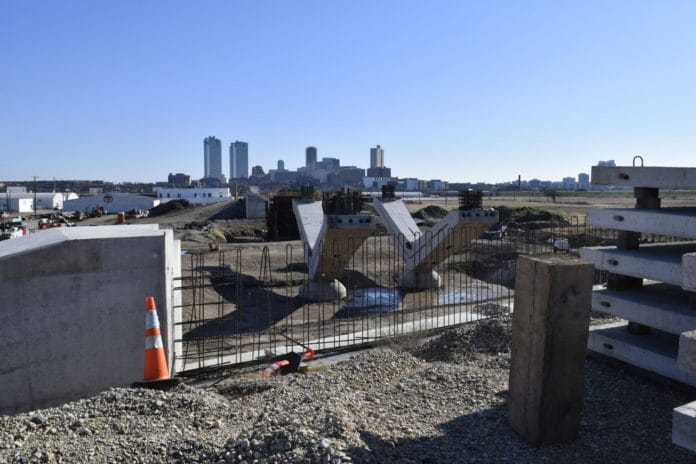The three bridges that are the most visible signs of progress for the Trinity River Vision project have again fallen behind schedule and are now not due to be finished for over than a year at the earliest.
The bridges that will eventually span the Trinity River and connect Panther Island with the mainland are in various stages of construction, said Kate Beck, project manager for bridge construction. This portion of the $1.16 billion Trinity River Vision project is the responsibility of the city of Fort Worth and the Texas Department of Transportation.
“A lot of progress has been made on all three bridges,” Beck reported to the Tarrant Regional Water District board of directors on Tuesday.
But the challenges of creating custom “unique” designed structures, highlighted by large V-pier supports, has resulted in a trial-and-error situation that creates issues with sizing and fitting the steel supports, said Greg Cedillo, construction director for the Texas Department of Transportation.
“We have a total of 20 V-piers and all are unique,” Cedillo said. If there was a uniform size for the V-piers, construction could move a lot faster, he said.
“It’s not good news but that’s where we are with the bridges,” Cedillo said.
Currently, the White Settlement bridge is furthest along and is expected to be finished by late summer 2020. The North Main bridge is expected to be completed in “late winter” of 2021 and the Henderson Street bridge is targeted to be finished in late spring of 2021.
The announcement of the bridge construction delay comes as the entire TRV project is facing increasing scrutiny and the Trinity River Vision Authority board is pushing ahead with a comprehensive review of the project, which has ballooned in cost from initial estimates of $360 million.
Four consulting firms have expressed intentions to bid for the job of conducting the review, officials told the TRWD board, and 10 other firms that attended a mandatory meeting for bidders are eligible to submit bids.
The TRWD is the agency overseeing the project as the parent organization of the Trinity River Vision Authority, which has direct supervision of the project.
The construction delay of the bridges is another bump in the rocky history of the TRV project, which is now in jeopardy since being bypassed for federal funding for three years in a row.
The TRVA is counting on a federal appropriation of $26 million in 2020 and another $35 million in 2021 to keep the project on track for 2028 completion.
Termed “The Boondoggle” by critics, the project’s detractors claim it is overly extravagant and too expensive – beginning with the bridge design. The comprehensive review will examine those claims as well as factors such as oversight and management.
The review will also examine reports that the project has been passed over for federal funding because it has become more of an economic development endeavor than strictly a flood control measure. As a result, the project partners, including the city of Fort Worth and Tarrant County along with the TRWD and the TRVA, may have to revise the project’s scope.
The project is looking for more than $500 million in federal funds to complete the project, which includes digging a channel and rerouting a 1.5-mile stretch of the Trinity River north of the Tarrant County Courthouse. The channel would replace the levees in that area of the river and would create the center island.
This is not the first delay in construction of the bridges. A design flaw detected in 2016 sent the bridge design back to the drawing board for reconsideration. At the time, TxDOT officials said the design could not be carried over from paper to reality.
At that time, the bridges were estimated to be competed in 2017-18 at a cost of $74 million.
The bridges have long been ridiculed by critics as bridges to nowhere because they are being built over dry land with no guarantee that water will eventually run under them.






